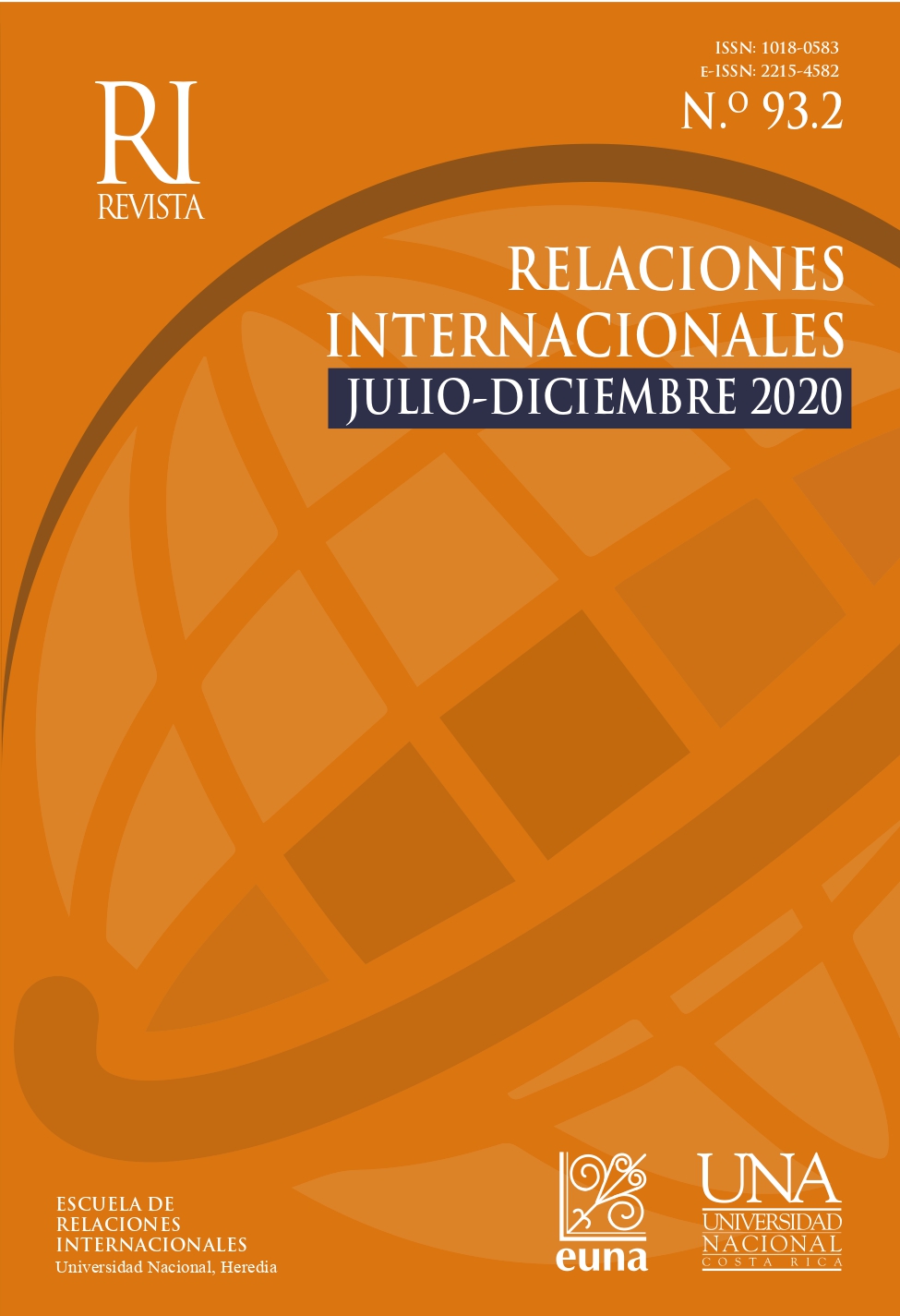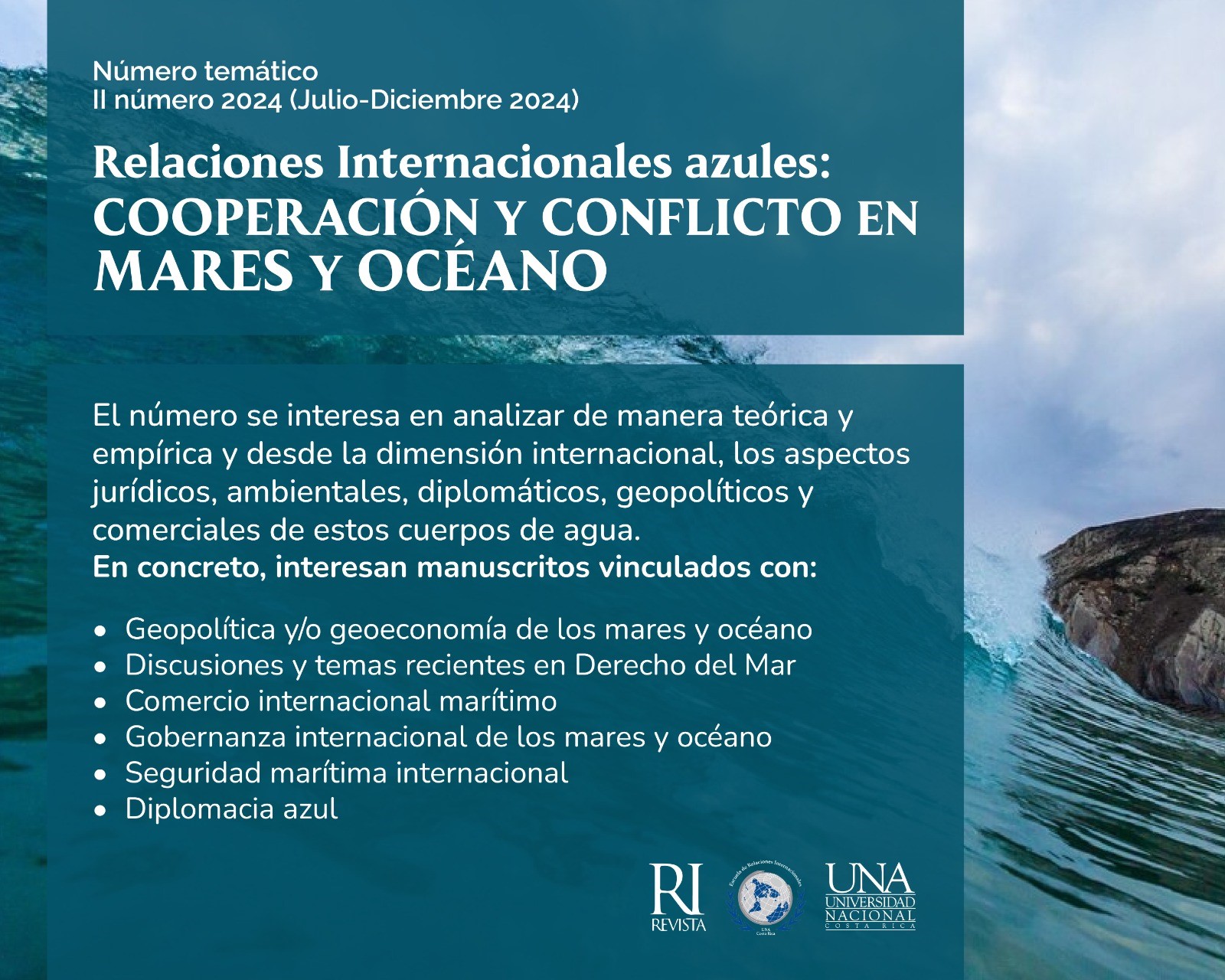Cuestión de amenaza: La influencia de los factores domésticos en el comportamiento de Vietnam y Malasia ante el ascenso del poder militar chino
DOI:
https://doi.org/10.15359/ri.93-2.3Palabras clave:
China, Vietnam, Malasia, Balance de poder, Realismo Neoclásico, Percepción del gobiernoResumen
En las últimas décadas China aumentó enormemente su poder, tanto en términos económicos como militares. Sin embargo, la respuesta de los actores de la región no fue homogénea; mientras que algunos recurrieron al balance de poder y el aumento de sus capacidades, otros evitaron este tipo de comportamiento. Entre 2013 y 2018, Vietnam elevó su gasto militar de forma continua, mientras que Malasia llegó incluso a disminuir el suyo, planteando un interrogante importante para el realismo estructural. A través de un estudio comparado entre ambos casos se concluye que el realismo neoclásico, que incorpora las creencias y las percepciones de los respectivos gobiernos y sociedades al análisis, ofrece una mejor explicación de los acontecimientos. En estos casos, las variables domésticas de cada Estado moldearon el accionar de sus gobernantes y jugaron un rol central en la percepción de China como una amenaza y la consecuente estrategia de respuesta ante su ascenso.
Referencias
Alatas, S. M. (2016). The South China Sea and Energy Security: Malaysia’s Reaction to Emerging Geopolitical Reconfigurations. African and Asian Studies, 15(1), 33-52.
Amer, R. (2004). Assessing Sino-Vietnamese Relations through the Management of Contentious Issues. Contemporary Southeast Asia, 26(2), 320-345.
Bakar, I. A. (2005). Malaysian perceptions of China. Historia Actual Online, 7, 93-105.
Banco Mundial (2019a). PBI (US$ a precios constantes de 2010). https://datos.bancomundial.org/indicador/NY.GDP.MKTP.KD
Banco Mundial (2019b). Población, total. https://datos.bancomundial.org/indicador/sp.pop.totl
Battaleme, J. (2015). Cambiando el status quo de la geopolítica internacional: El acceso a los espacios comunes y las estrategias de negación de espacio y antiacceso. https://repositorio.uade.edu.ar/xmlui/handle/123456789/6367
BBC (2011). South China Sea: Vietnamese hold anti-Chinese protest. BBC News. https://www.bbc.com/news/world-asia-pacific-13661779
BBC (2012). Vietnam refuses to stamp new Chinese passports over map. BBC News. https://www.bbc.com/news/world-asia-20491426
BBC (2016). South China Sea: Vietnam airport screens hacked. BBC News. https://www.bbc.com/news/world-asia-36927674
Beckley, M. (2017). The Emerging Military Balance in East Asia. How China’s Neighbors Can Check Chinese Naval Expansion. International Security, 42(2), 78–119.
Brooks, S. G. (1997). Dueling Realisms. International Organization, 51(3), 445-477.
Buzan, B., y Cox, M. (2013). China and the US: Comparable cases of ‘peaceful rise’? The Chinese Journal of International Politics, 6(2), 109-132.
Cai, P. (2017). Understanding China’s belt and road initiative. Lowy Institute for International Policy, 1-22.
Central Intelligence Agency. (2020). The World Factbook. https://www.cia.gov/library/publications/the-world-factbook/
Chen, S., y Feffer, J. (2009). China’s military spending: soft rise or hard threat? Asian Perspective, 33(4) 47-67.
Chu, Y., y Chang, Y. (2017). Battle for Influence: Perceptions in Asia of China and the US. Global Asia, 12(1), 104-111.
Cotillon, H. (2017). Territorial Disputes and Nationalism: A Comparative Case Study of China and Vietnam. Journal of Current Southeast Asian Affairs, 36(1), 51–88.
Economy, E. (2018). China’s new revolution: The reign of Xi Jinping. Foreign Affairs, 97, 60-74.
Gerring, J. (2001). Social Science Methodology: A Criterial Framework. Cambridge University Press.
Hill, H. (2012). Malaysian economic development: looking backward and forward. Malaysia’s development challenges: Graduating from the middle, 40.
Hung, N. M. (2018). VIETNAM IN 2017: Power Consolidation, Domestic Reforms, and Coping with New Geopolitical Challenges. Southeast Asian Affairs, 2018, 407-428.
Instituto Internacional de Estudios Estratégicos. (2018). The Military Balance. The Annual Assessment of Global Military Capabilities and Defence Economics.
Kaplan, R. D. (2014). Asia’s Cauldron: The South China Sea and the End of a Stable Pacific. Ballantine Books.
Karim, M. F., y Chairil, T. (2016). Waiting for Hard Balancing?: Explaining Southeast Asia’s Balancing Behaviour towards China. European Journal of East Asian Studies, 15(1), 34-61.
Keling, M.F., Ajis, M.N., Shuib, M.S., Othman, M.F., y Som, H.M. (2011). The Malaysian Government’s Efforts in Managing Military and Defence Development. International Journal of Business and Social Science, 2(12), 180-192.
Kreuzer, P. (2016). A Comparison of Malaysian and Philippine Responses to China in the South China Sea. The Chinese Journal of International Politics, 9(3), 239–276.
Ku, S. (2017). Strategies of China’s Expansion and Taiwan’s Survival in Southeast Asia: A Comparative Perspective. En L. Dittmer (Ed.), Taiwan and China, (pp. 249-279). University of California Press.
Kuik, C. (2013). Making Sense of Malaysia’s China Policy: Asymmetry, Proximity, and Elite’s Domestic Authority. The Chinese Journal of International Politics, 6(4), 429–467.
Kuik, C. (2015). Variations on a (Hedging) Theme: Comparing ASEAN Core States’ Alignment Behavior. Joint U.S.-Korea Academic Studies, 26, 11-26.
Kuik, C. (2016). Malaysia Between the United States and China: What do Weaker States Hedge Against? Asian Politics & Policy, 8(1), 155-177.
Kuik, C. (2017). Tempting Torch? Malaysia Embraces (and Leverages on) BRI Despite Domestic Discontent. Praxis: A Review of Policy Practice. Asian Politics & Policy, 9(4), 652-654.
Kurlantzick, J. (2015). China-Vietnam Military Clash. Council on Foreign Relations.
Lean, H. H., y Smyth, R. (2016). The Malaysia–China economic relationship at 40: Broadening ties and meeting the challenges for future success. En H. Lean y R. Smyth (Eds.), Chinese global production networks in ASEAN (pp. 39-52). Springer International Publishing.
Liff, A. P. y Ikenberry, G. J. (2014). Racing toward Tragedy? China’s Rise, Military Competition in the Asia Pacific, and the Security Dilemma. International Security, 39(2), 52-91.
Lobell, S. E., Ripsman, N. M., y Taliaferro, J. W. (2009). Neoclassical Realism, the State, and Foreign Policy, Diplomacy & Statecraft, 24(4), 691-693.
Mearsheimer, J. (2001). The Tragedy of Great Power Politics. W.W. Norton & Company.
Ministerio de Relaciones Exteriores de Vietnam (19 de mayo de 2014). Peace, Stability in East Sea under Serious Threat, Says PM. www.mofa.gov.vn/en/nr040807104143/nr040807105001/ns140512151537/view
Morris-Jung, J., y Min, P. (2017). Anti-Chinese Protest in Vietnam: Complex Conjunctures of Resource Governance, Geopolitics and State–Society Deadlock. En J. Morris-Jung (Ed.), China’s Backyard: Policies and Politics of Chinese Resource Investments in Southeast Asia (pp. 229-255). ISEAS–Yusof Ishak Institute.
Morrison, W. M. (2014). China’s economic rise: History, trends, challenges, and implications for the United States. Congressional Research Service.
Nguyen, T. (2016). Accommodating the dragon: Vietnam’s enduring asymmetric entanglements with China. Hong Kong Baptist University.
Parameswaran, P. (2016). MALAYSIA IN 2015: Crises of Confidence. En M. Cook y D. Singh (Eds), Southeast Asian Affairs (pp. 183-197). ISEAS-Yusof Ishak.
Pham, D. N. (2016). From Marx to Market: The Debates on the Economic System in Vietnam’s Revised Constitution. Asian Journal of Comparative Law, 11(2), 263-285.
Phi, V. (2012). Regional Development along Economic Corridors: Southern Coastal and Northern Sub-Corridors in Vietnam. En M. Ishida (Ed.), Emerging Economic Corridors in the Mekong Region. Bangkok Research Center.
Rinehart, I. E. (2015). Malaysia: Background and us relations. Congressional Research Service.
Ripsman, N. M., Taliaferro, J. W., y Lobell, S. E. (2016). Neoclassical realist theory of international politics. Oxford University Press.
Rocha Pino, M. (2020). La proyección de la Iniciativa Cinturón y Ruta de la Seda en la Unión Europea (2014-2019): Implicaciones económicas y normativas. Relaciones Internacionales, 93(2), 19-46. https://doi.org/10.15359/ri.93-2.1
Rose, G. (1998). Neoclassical Realism and Theories of Foreign Policy. World Politics, 51(1), 144-172.
Rubbi, L. (2018). Guerra asimétrica: La estrategia de defensa de la República Popular China en el período 2012 – 2016 [Tesis de maestría]. Universidad Torcuato Di Tella.
Schweller, R. (2016). The Balance of Power in World Politics. Politics: Oxford Research Encyclopedias. 10.1093/acrefore/9780190228637.013.119
Schweller, R. (2018). Opposite but Compatible Nationalisms: A Neoclassical Realist Approach to the Future of US–China Relations. The Chinese Journal of International Politics, 11(1), 23–48.
Shoji, T. (2018). Vietnam’s Security Cooperation with the United States: Historical Background, Present and Future Outlook. NIDS Journal of Defense and Security, 19, 3-16.
SIPRI. (2012). Trends in International Arms Transfers, 2011. SIPRI Fact Sheet.
SIPRI. (2018a). El gasto militar mundial se mantiene alto en 1,7 billones de dólares. https://www.sipri.org/sites/default/files/2018-05/milex_press_release_esp.pdf
SIPRI. (2018b). SIPRI Yearbook 2018: Armaments. Disarmament and International Security.
SIPRI. (2019a). Military Expenditure Database. https://www.sipri.org/databases/milex
SIPRI (2019b). Trends in World Military Expenditure, 2018. SIPRI Fact Sheet.
South China Morning Post. (2014). Vietnam arrests demonstrators in renewed anti-Chinese protests. https://www.scmp.com/news/asia/article/1514821/vietnam-arrests-demonstrators-renewed-anti-chinese-protests
South China Morning Post. (2014, 16 de mayo). In Vietnam’s anti-Chinese protests, violence will only add fuel to fire. https://www.scmp.com/comment/insight-opinion/article/1513049/vietnams-anti-chinese-protests-violence-will-only-add-fuel
South China Morning Post. (2014, 18 de mayo). Vietnam arrests demonstrators in renewed anti-Chinese protests. https://www.scmp.com/news/asia/article/1514821/vietnam-arrests-demonstrators-renewed-anti-chinese-protests
Storey, I. (2018). Asia y el nuevo (des)orden mundial. En La era de la perplejidad. Repensar el mundo que conocíamos. BBVA. https://www.bbvaopenmind.com/wp-content/uploads/2018/01/BBVA-OpenMind-La-era-de-la-perplejidad-repensar-el-mundo-que-conociamos.pdf
Strasakova, M. (2017). Sino-Vietnamese Relations: Accommodating the Dragon? ISA International Conference 2017, University of Hong Kong.
Sun, O. E., y Han, D. (2016). Malaysia’s Relations with the Major Powers: China and the United States. S. Rajaratnam School of International Studies. http://hdl.handle.net/11540/9268
Swaine, M. D. (2010). Perceptions of an Assertive China. China Leadership Monitor, 32(2), 1-19.
Thayer, C. A. (2018). Force Modernization: Vietnam. En D. Singh y M. Cook, Southeast Asian Affairs 2018 (pp. 429-444). ISEAS-Yusof Ishak.
Toai, D. B., Guan, X., y Ghimire, A. (2018). Situational Analysis of Vietnam for Belt and Road Initiative. Advances in Economics, Business and Management Research, 67,176-181.
Ton, A. D. (2018). Vietnam’s Maritime Security Challenges and Regional Defence and Security Cooperation. Soundings, 4.
Tran, T. U. (2018). Coping with a rising power: Vietnam’s hedging strategy toward China. Naval Postgraduate School.
Tuoi Tre News. (2016, 22 de enero). Vietnam will confront new maritime challenges, difficulties: military general. https://tuoitrenews.vn/politics/32895/vietnam-will-confront-new-maritime-challenges-difficulties-military-general
Vélez Serrano, M. (2018). De dragón revolucionario, a tímido, y ahora rejuvenecido. Relaciones Internacionales, 91(2), 1-23. https://doi.org/10.15359/ri.91-2.4
Walt, S. M. (1985). Alliance Formation and the Balance of World Power. International Security, 9(4), 3-43.
Walt, S. M. (1990). The origins of alliance. Cornell University Press.
Waltz, K. N. (1979). Theory of international politics. Addison-Wesley.
Womack, B. (2006). China and Vietnam: The Politics of Asymmetry. Cambridge University Press.
Wu, S. (2019). Vietnam: a case of military obsolescence in developing countries. The Pacific Review, 32(1), 113-130.
Publicado
Cómo citar
Número
Sección
Licencia
Esta publicación está adscrita a Creative Commons; deben respetarse sus atribuciones y restricciones.
Los autores/as que publiquen en esta revista aceptan las siguientes condiciones:
- Los autores/as conservan los derechos de autor y ceden a la revista el derecho de la primera publicación, con el trabajo registrado con la Licencia Creative Commons Atribución-NoComercial-CompartirIgual 4.0 Internacional, que permite a terceros utilizar lo publicado siempre que mencionen la autoría del trabajo y a la primera publicación en esta revista.
- Los autores/as pueden realizar otros acuerdos contractuales independientes y adicionales para la distribución no exclusiva de la versión del artículo publicado en esta revista (p. ej., incluirlo en un repositorio institucional o publicarlo en un libro) siempre que indiquen claramente que el trabajo se publicó por primera vez en esta revista.
- Se permite y recomienda a los autores/as a publicar su trabajo en Internet (por ejemplo en páginas institucionales o personales) antes y durante el proceso de revisión y publicación, ya que puede conducir a intercambios productivos y a una mayor y más rápida difusión del trabajo publicado.
Revista de Relaciones Internacionales por Universidad Nacional de Costa Rica está bajo una Licencia Creative Commons Atribución-NoComercial-SinDerivar 4.0 Internacional









.png)



2.png)
